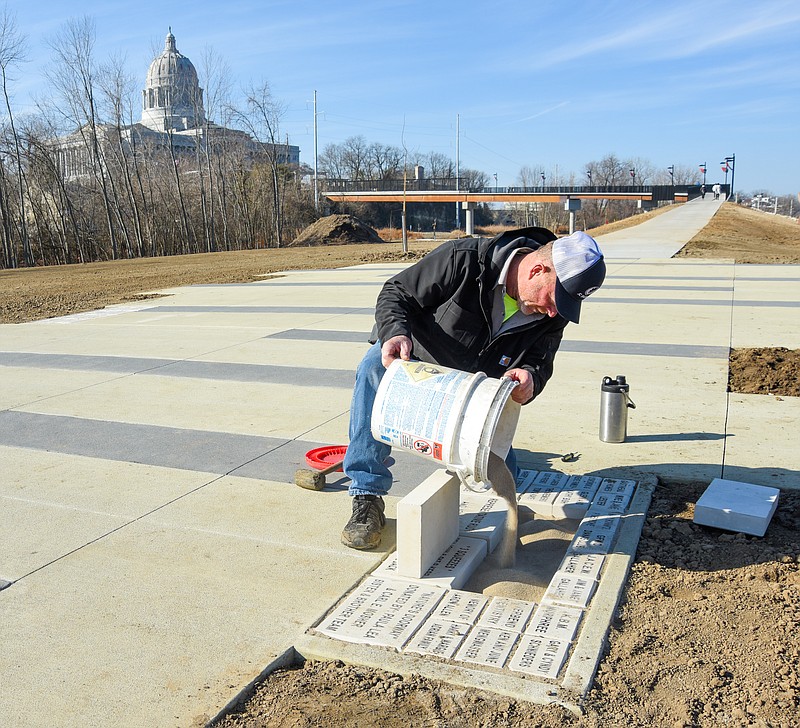Mayor Carrie Tergin had two pavers removed from an Adrian’s Island plaza over concern they too closely resemble a Civil War monument the City Council removed last year after weeks of contentious debate.
As a fundraising vehicle for the Bicentennial Bridge, people could purchase brick pavers that go along the path on Adrian’s Island.
The 765-foot bridge, which stretches over the Union Pacific Railroad track, connects the Capitol grounds with the 30-acre strip of land on the other side of the railroad tracks referred to as Adrian’s Island.
The bridge opened Monday and allows access onto the island. Crews are still working on elements of the park, but a concrete walking path is open with pavers along part of it.
Two of the larger fundraising pavers were removed from the path Thursday.
The bricks, which lay next to each other, had been purchased by a city resident and had been engraved with part of the language on the Sterling Price marker, Tergin said Thursday.
The original Sterling Price marker on Moreau Drive said, “Deciding against attack, the Confederate Army under Gen. Sterling Price turned from Jefferson City October 7, 1864. This marker dedicated April 6, 1933 by Winnie Davis Chapter United Daughters of the Confederacy.”
The United Daughters of the Confederacy, which purchased the marker, has ties to the Ku Klux Klan, which ultimately played a large role in the City Council’s decision to remove the original marker.
In October 2020, the City Council voted to remove the marker from where it stood on Moreau Drive.
The pavers placed on Adrian’s Island said, “Union Camp Lillie notes: deciding against attack the confederate army under Gen. Sterling Price turned from Jefferson City Oct. 7, 1864.”
Jefferson City resident Edith Vogel purchased the pavers and said her intention had nothing to do with the original monument.
“It was the furthest thing from my mind to be talking about the Confederate rock that was removed last year, which was purchased by the Daughters of the Confederacy,” she said Thursday. “I’m a daughter of the Union, but I’m trying to save the historical significance of that event because we have nothing except a replica of the plaque that I have on my private property.”
Vogel is the current owner of what was Camp Lillie, which was a base for Union soldiers. In April, she put up a replica of the plaque from the original Sterling Price marker on the property.
Vogel said she and some of her friends got together and purchased the pavers to recognize the historical significance of Sterling not attacking Jefferson City.
“I’m a descendant of G.H. Dulle, who was living at the time at 800 St. Mary’s Boulevard,” Vogel said. “He was told by the Union army to get out, and they took over his house. He survived. If they’d decided to attack Jefferson City, he could have been killed, and I might not be here.”
Tergin said she decided to remove the pavers on Adrian’s Island because the messaging didn’t align with the original intention of the pavers, and the council had already made a decision about having the language on city-owned property.
“I likely don’t have the last word, and I’m sure my decision could be reversed, but I spoke with the donor about the concerns before making the decision,” she said. “A big part of this particular message was that council made a decision to remove the rock and the pavers in question reference that rock.”
The goal of the pavers, she said, is to honor individuals and donors to the Bicentennial Bridge project.
“I made the decision myself, based on the history of that decision to remove those (words from city-owned property),” Tergin said, “also clarifying moving forward the intent of the bricks.”
The form to purchase pavers will be updated and will clarify that the bricks are meant for names, she said.
“The original intent was for names,” she said. “Honestly, it’s something that the committee didn’t necessarily think about clarifying on the sheet, although now in hindsight, it should have been clarified … so that donors would know what the intent was. Typically, donor bricks and pavers are for names.”
There was no review or approval process when somebody purchased a paver, she said.
Another paver at the plaza is engraved with the Bible verse John 3:16.
When asked if that paver should be removed because it’s not a name, Tergin said it was a good question. She said she would likely talk to the donor of that paver as well.
Vogel said city officials told her they would give her two more markers that she could use to honor somebody in her family, but that isn’t her intention.
“I wanted to remind the people that walk on that bridge and go down and look at those plaques that say there was not a battle here in Jefferson City,” she said. “If they don’t want to look at that, well close their eyes or look away. … There was no stipulation of what could go on the paver … or else I would have said, ‘Well, I won’t do that.’
“If you just want names of people that are dead that I’m trying to remember, then I don’t want to participate,” Vogel said.
Tergin said she is taking full responsibility for the misunderstanding and it not being noticed before the pavers went in.
“I will take full responsibility that even when I proofread the donor sheet, I never thought about clarifying (they’re for names),” she said. “I just made the assumption that that’s what they would do, because typically, paver campaigns are for names. They’re very small.”
Tergin said Vogel can put something else on the pavers or receive a refund.
Vogel said she plans to ask for a refund.
Parks Director Todd Spalding deferred to Tergin on the matter; Parks Commission President Chris Leuckel could not be reached for comment.

